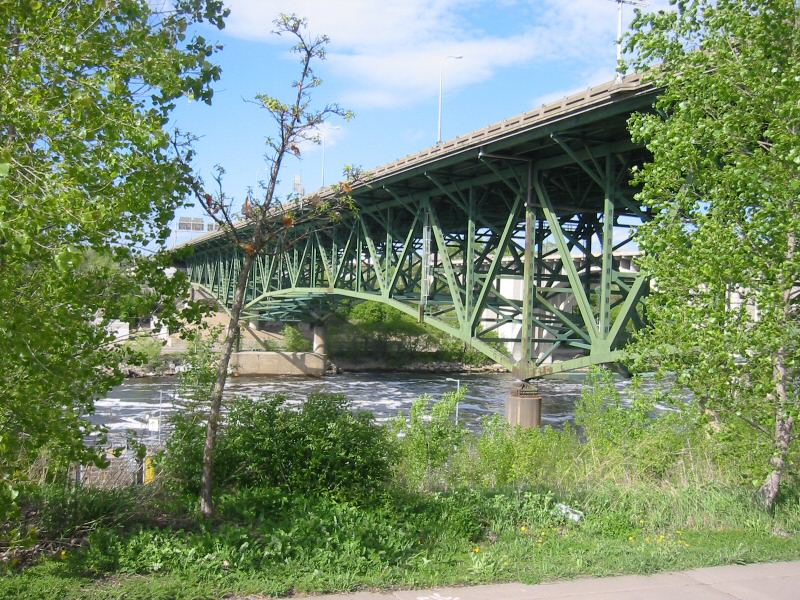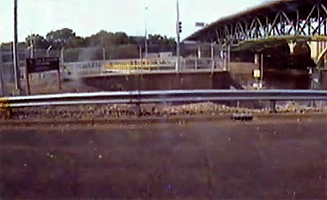General Discussion
Related: Editorials & Other Articles, Issue Forums, Alliance Forums, Region Forums12 Years Ago Today; I-35W Mississippi River bridge collapse kills 13 in rush hour traffic

Bridge 9340 in May 2006 (prior to collapse)
The I-35W Mississippi River bridge (officially known as Bridge 9340) was an eight-lane, steel truss arch bridge that carried Interstate 35W across the Saint Anthony Falls of the Mississippi River in Minneapolis, Minnesota, United States. The bridge opened in 1967 and was Minnesota's third busiest, carrying 140,000 vehicles daily. It had a catastrophic failure during the evening rush hour on August 1, 2007, killing 13 people and injuring 145. The NTSB cited a design flaw as the likely cause of the collapse, noting that a too-thin gusset plate ripped along a line of rivets, and additional weight on the bridge at the time contributed to the catastrophic failure.
Help came immediately from mutual aid in the seven-county Minneapolis–Saint Paul metropolitan area and emergency response personnel, charities, and volunteers. Within a few days of the collapse, the Minnesota Department of Transportation (Mn/DOT) planned its replacement with the I-35W Saint Anthony Falls Bridge. Construction was completed rapidly, and it opened on September 18, 2008.
<snip>
Design and construction
The bridge, officially designated "Bridge 9340", was designed by Sverdrup & Parcel to 1961 AASHO (American Association of State Highway Officials, now American Association of State Highway and Transportation Officials) standard specifications. The construction contracts, worth in total more than US$5.2 million at the time, were initially offered to HurCon Inc. and Industrial Construction Company. HurCon expressed concern about the project, reporting that one portion of the bridge, Pier 6, could not be built as planned. After failed discussions with MnDOT, HurCon backed out of the project altogether.
Construction on the bridge began in 1964 and the structure was completed and opened to traffic in 1967 during an era of large-scale projects to build the Twin Cities freeway system. When the bridge fell, it was still the most recent river crossing built on a new site in Minneapolis. After the building boom ebbed during the 1970s, infrastructure management shifted toward inspection and maintenance.
The bridge's fourteen spans extended 1,907 feet (580 m) long. The three main spans were of deck truss construction while all but two of the eleven approach spans were steel multi-girder construction, the two exceptions being concrete slab construction. The piers were not built in the navigation channel; instead, the center span of the bridge consisted of a single 458-foot (140 m) steel arched truss over the 390-foot (119 m) channel. The two support piers for the main trusses, each with two load-bearing concrete pylons at either side of the center main span, were located on opposite banks of the river. The center span was connected to the north and south approaches by shorter spans formed by the same main trusses. Each was 266 feet (81 m) in length, and was connected to the approach spans by a 38-foot (11.6 m) cantilever. The two main trusses, one on either side, ranged in depth from 60 feet (18.3 m) above their pier and concrete pylon supports, to 36 feet (11 m) at midspan on the central span and 30 feet (9 m) deep at the outer ends of the adjoining spans. At the top of the main trusses were the deck trusses, 12 feet (3.6 m) in depth and integral with the main trusses. The transverse deck beams, part of the deck truss, rested on top of the main trusses. These deck beams supported longitudinal deck stringers 27 inches (69 cm) in depth, and reinforced-concrete pavement. The deck was 113 ft 4 in (34.5 m) in breadth and was split longitudinally. It had transverse expansion joints at the centers and ends of each of the three main spans. The roadway deck was approximately 115 feet (35 m) above the water level.
Collapse

Security camera images show the collapse in animation, looking north.

Bridge as seen from above after the collapse
At 6:05 p.m. CDT on Wednesday, August 1, 2007, with rush hour bridge traffic moving slowly through the limited number of lanes, the central span of the bridge suddenly gave way, followed by the adjoining spans. The structure and deck collapsed into the river and onto the riverbanks below, the south part toppling 81 feet (25 m) eastward in the process. A total of 111 vehicles were involved, sending their occupants and 18 construction workers as far as 115 feet (35 m) down to the river or onto its banks. Northern sections fell into a rail yard, landing on three unoccupied and stationary freight cars.

Cars that were on the bridge when it collapsed remain in the wreckage. They were numbered as part of the investigation.
Sequential images of the collapse were taken by an outdoor security camera located at the parking lot entrance of the control facility for the Lower Saint Anthony Falls Lock and Dam. The immediate aftermath of the collapse was also captured by a Mn/DOT traffic camera that was facing away from the bridge during the collapse itself. The federal government immediately launched a National Transportation Safety Board (NTSB) investigation. NTSB chairman Mark Rosenker, along with a number of investigators, arrived on scene nine hours after the collapse. Rosenker remained in Minneapolis for nearly one week, serving as the government's designated primary interface with federal, state and local officials as well as briefing the press on the status of the investigation.
Mayor R. T. Rybak and Governor Tim Pawlenty declared a state of emergency for the city of Minneapolis and for the State of Minnesota on August 2, 2007. Rybak's declaration was approved and extended indefinitely by the Minneapolis City Council the next day. As of the morning following the collapse, according to White House Press Secretary Tony Snow, Minnesota had not requested a federal disaster declaration. President Bush pledged support during a visit to the site on August 4 with Minnesota elected officials and announced that United States Secretary of Transportation (USDOT) Mary Peters would lead the rebuilding effort. Rybak and Pawlenty gave the president detailed requests for aid during a closed-door meeting. Local authorities were assisted by the Federal Bureau of Investigation (FBI) evidence team, and by United States Navy divers who began arriving on August 5, 2007.
Victims
Thirteen people were killed. Triage centers at the ends of the bridge routed 50 victims to area hospitals, some in trucks, as ambulances were in short supply. Many of the injured had blunt trauma injuries. Those near the south end were taken to Hennepin County Medical Center (HCMC) — those near the north end, to the Fairview University Medical Center and other hospitals. At least 22 children were injured. Thirteen children were treated at Children's Hospitals and Clinics of Minnesota, five at HCMC and four or five at North Memorial Medical Center in Robbinsdale, Minnesota. During the first 40 hours, 11 area hospitals treated 98 victims.
Only a few of the vehicles were submerged, but many people were stranded on the collapsed sections of the bridge. Several vehicles caught fire, including a semi-trailer truck, from which the driver's body was later recovered. When fire crews arrived, they had to route hoses from several blocks away.
A school bus carrying 63 children ended up resting precariously against the guardrail of the collapsed structure, near the burning semi-trailer truck. The children were returning from a field trip to a water park as part of the Waite House Neighborhood Center Day Camp based in the Phillips community. Jeremy Hernandez, a 20-year-old staff member on the bus, assisted many of the children by kicking out the rear emergency exit and escorting or carrying them to safety. One youth worker was severely injured.
Rescue
Civilians immediately took part in the rescue efforts. Minneapolis and Hennepin County received mutual aid from neighboring cities and counties throughout the metropolitan area. The Minneapolis Fire Department (MFD) arrived in six minutes and responded quickly, helping people who were trapped in their vehicles. They took 81 minutes to triage and transport 145 patients with the help of Hennepin County Medical Center (HCMC), North Memorial and Allina paramedics. By the next morning, they had shifted their focus to the recovery of bodies, with several vehicles known to be trapped under the debris and several people still unaccounted for. Twenty divers organized by the Hennepin County Sheriff's Office (HCSO) used side-scan sonar to locate vehicles submerged in the murky water. Their efforts were hampered by debris and challenging currents. The United States Army Corps of Engineers (USACE) lowered the river level by two feet (60 cm) downriver at Ford Dam to allow easier access to vehicles in the water. Carl Bolander & Sons, a Saint Paul-based earthworks and demolition company, brought in several cranes and other heavy machinery to assist in clearing debris for rescue workers.

Ninety-three people were rescued from the collapsed bridge. Minneapolis Fire Department boats on the Mississippi River took about twenty people. The rescue lasted about three hours.
The Minneapolis Fire Department (MFD) created the National Incident Management System command center in the parking lot of the American Red Cross and an adjacent printing company on the west bank. The Minneapolis Police Department (MPD), Minnesota State Patrol and the University of Minnesota Police secured the area, MFD managed the ground operations, and HCSO was in charge of the water operation. The city provided 75 firefighters and 75 law enforcement units.
Rescue of victims stranded on the bridge was complete in three hours. "We had a state bridge, in a county river, between two banks of a city. ... But we didn't have one problem with any of these issues, because we knew who was in charge of the assets," said Rocco Forte, city Emergency Preparedness Director. City, metropolitan area, county and state employees at all levels knew their roles and had practiced them since the city received FEMA emergency management training the year following the September 11, 2001 attacks. Their rapid response time is also credited to the Minnesota and United States Department of Homeland Security (DHS) investment in 800 MHz mobile radio communications that were operating in Minneapolis and three of the responding counties, the city of Minneapolis collapsed-structures rescue and dive team, and the Emergency Operations Center established at 6:20 p.m. in Minneapolis City Hall.
</snip>
FakeNoose
(32,645 posts)Not that I was in Minneapolis when it happened. I live in Pittsburgh and in Allegheny County we have thousands of bridges (no exaggeration) and many of them are older than the bridge that collapsed in Minneapolis. This failure put the fear of God into our county engineers who immediately went around inspecting our bridges, tunnels and ramps. Several were closed or judged unsafe until repairs could be made.
The Minneapolis bridge failure is what caused our infrastructure teams to finally get off their asses and do the necessary repairs that had been delayed for lack of funds. To this day - 12 years later - we're still making repairs in the Pittsburgh area, but the major work is already done.
![]()
malaise
(269,050 posts)What made it worse was that I had posted about the likelihood of a bridge collapsing (given the state of infrastructure) just a few days before.